Updated: February 2022
Many of us may suffer from sore muscles, back and shoulder pain, or even a stiff neck even though our daily lives aren’t physically demanding. The culprit is often bad posture, a side effect of spending a lot of time at a desk or glancing down at your mobile device throughout the day.

Fortunately, there are things you can do to counteract the effects of bad posture! In this post, we cover everything you need to know about posture and how you can improve yours to feel better — fast!
What is posture?
Posture mainly refers to the alignment of your spine with respect to your head, shoulders, and hips when you are standing, sitting and even sleeping. Good posture means a neutral spine that allows for natural body alignment which reduces the stress on your muscles, joints, and ligaments. There are two kinds of posture:
- Dynamic posture: how we hold ourselves when we are moving
- Static posture: how we hold ourselves when we are not moving
With both dynamic and static posture, it is important to make sure you are holding your body in a way that maintains the natural curvature of your spine.
Maintaining your spine in the proper position creates a healthy spine that not only supports your body but also plays a huge role in your central nervous system. Good posture helps maintain spinal health and is integral to our physical and mental well-being. By checking for and maintaining good posture, we can keep ourselves healthy and help to avoid pain and injury.
How can I check my posture?
In an ideal standing posture, the head is in a neutral position with the ears lined up with the middle or tips of the shoulders. The Upper and lower back is straight with only a small curve in the small of your back. The top of the hips is in alignment with shoulders, knees and ankles.
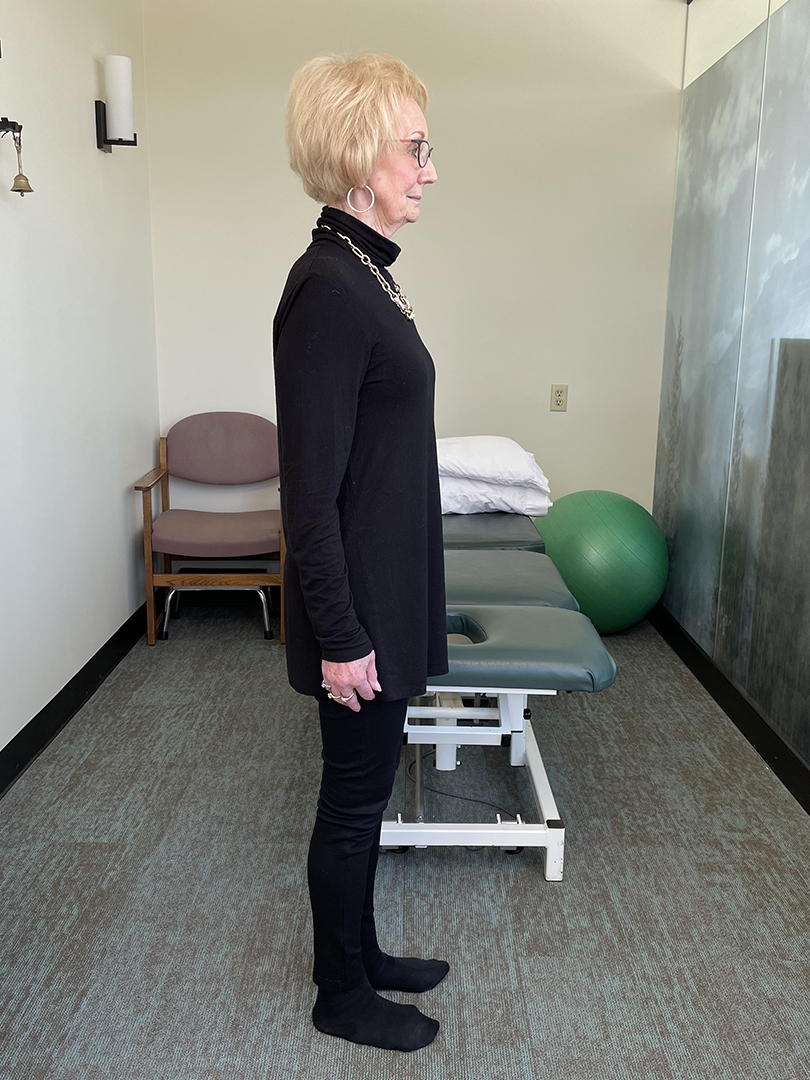
The easiest way to check your posture is to do the wall test. Stand with your back against a wall and make sure that your head, shoulder blades and buttocks are in contact with the wall and that heels are about 2 inches away. Place your palm on the wall in the space created by the curve of your lower back. You should only have about one hand’s thickness between your back and the wall.
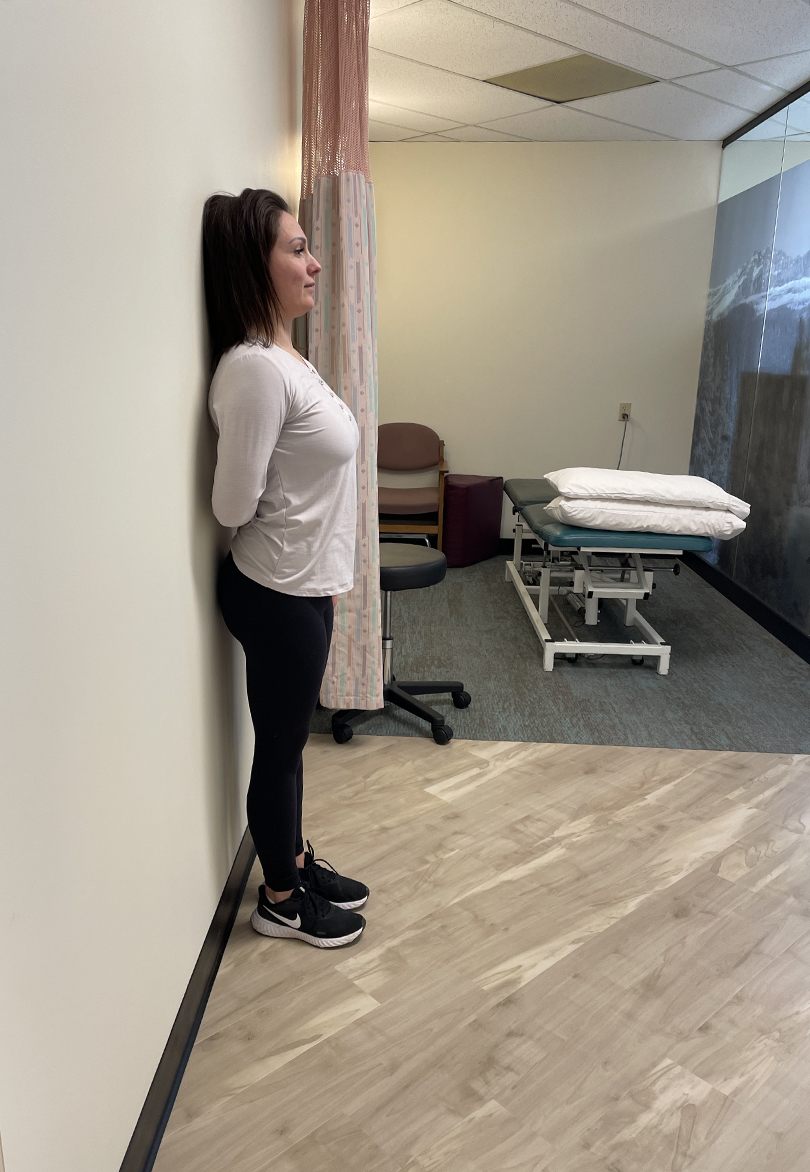
If there is too much or too little space, experiment with contracting your abs along with your glutes or arching your back until your hand fits comfortably behind your lower back as described above.
How does bad posture affect my health?
Poor posture isn’t just uncomfortable — it can be downright unhealthy. Over time, bad posture can compromise the natural S shape of the spine causing stress and pressure in the wrong places within the body. And by compromising the structure of the spine and the supporting structures, we also lessen the spine’s ability to absorb shock which increases the risk of injury.
Slouching and a forward head posture, for instance, can create a misalignment of your upper and lower teeth when you close your mouth. This can put excessive strain on the muscles around your jaw and increase your risk of developing problems with your temporomandibular joint (TMJ). If you tend to hunch over your keyboard and never address your poor posture, you will develop rounded shoulders and an excessive forward curvature in your upper back, which can result in shoulder pain, especially with over-head activities and possible numbness and tingling in your arms and hands. Prolonged hunching can also affect your muscles, causing headaches or migraines, neck and upper back pain, shoulder problems, and weakness in the upper and lower back.
Can I correct years of bad posture, or is it too late?
It is never too late to start making changes to correct your posture. Correcting years of bad posture can take time, but the sooner you start to improve your posture the sooner your body will respond and improve! And it’s not nearly as hard as you might think. Read on to find out how you can start improving your posture now.
How To Improve Your Posture Overall
One of the quickest ways to correct your posture is to simply make sure you’re not slouching. Sit or stand tall. Relax your shoulders and gently un-round them by pulling them back and gently squeezing your shoulder blades together. Lastly, pull your chin in towards your throat a small amount.
Follow the steps below to help improve your posture:
1. Pay attention to how you hold your body.
The first step to improving your posture is to pay attention to how you hold your body. Do you hunch your shoulders when you stand? Do you slouch when you sit at your desk? Do you lean into your computer screen when at your desk? Or do you hold your shoulders high and tense while driving?
Remain aware of your posture throughout the day so you can start to practice fixing it regularly. Use cues throughout the day to remind you to pay attention to how you’re holding posture such as red lights while driving, texts from a significant other or commercial breaks while watching tv.
2. Set up a positive posture environment.
Next, make sure your environment encourages good posture. If you are on your feet a lot, ensure you are wearing shoes that have good arch support and try to avoid high heels. Pay attention to your work and driving set up to make sure everything is positioned at the right height and is ergonomically correct. For more information on proper workplace setup, keep reading.
3. Avoid slouching at all costs!
This includes slouching when walking, driving, sitting, etc. Also avoid staring down at phones or tablets, which encourages bad posture and can cause neck pain (‘text neck’ is a real thing).
Get in the habit of bringing devices up to eye level rather than looking down. If you can’t avoid looking down, such as with cooking, keep your neck straight (as if you’re looking straight ahead) but nod your head down, slightly bringing your chin to your throat.
4. Stay active.
Lastly, stay active. Maintaining a healthy weight and keeping your body strong, toned and healthy will help build and support the strength of your core. Activities like yoga, tai chi, and pilates are beneficial for their focus on fluid movement and body awareness, but any exercise that targets the abs, glutes and back muscles are encouraged.
Regular movement is key. Try to not sit for long periods of time. Getting up and moving around every 20-30 minutes will help you avoid getting stiff. Some easy ways to do this are:
- Standing when you’re talking on the phone.
- Filling your coffee or water glass half full to force yourself to get up to fill it twice as often.
- Setting a timer to remind you to get up and move around.
- Moving your printer to a separate room further down the hall.
- Keeping snacks or your lunch up or downstairs from where you’re sitting.
Walking on a regular basis is also a great way to stay in shape and keep your body moving. If you are experiencing pain, or are concerned about your posture, check in with your doctor or physiotherapist for an assessment.
How To Improve Posture While Standing
Improving your posture is all about awareness. If you did the wall test mentioned above, you’ll have a good idea of your current standing posture and where you may need to improve. Although slouching can be inevitable, especially when we are tired, good posture requires diligence.
To improve your posture when standing:
- Stand up straight with shoulders relaxed and back and feet shoulder-distance apart.
- Let your arms hang naturally by your sides and tuck in your tummy.
- Keep your weight slightly on the balls of your feet and allow your knees to bend a small amount.
- Pull your chin back and imagine you are standing with your back against a wall.
If you find you have a hard time adjusting your posture, or you have a long history with bad posture, there are a variety of posture correcting devices available that you can wear throughout the day to keep your back and posture in alignment.
How To Improve Posture While Sitting
It is easy to forget about posture when sitting down at the dinner table or watching TV on the couch, but these are key times to pay attention to our posture since we are more prone to slouching!
To improve posture while sitting, remember to sit tall and not slouch, keep your shoulders rolled back and positioned above the hips. If you’re in a chair, your buttocks should touch the back of the chair. To get yourself into a good sitting posture, try stretching up and accentuating the curve of your back. Hold this position for a couple of seconds then release slightly. This is the posture you should try to maintain while sitting.
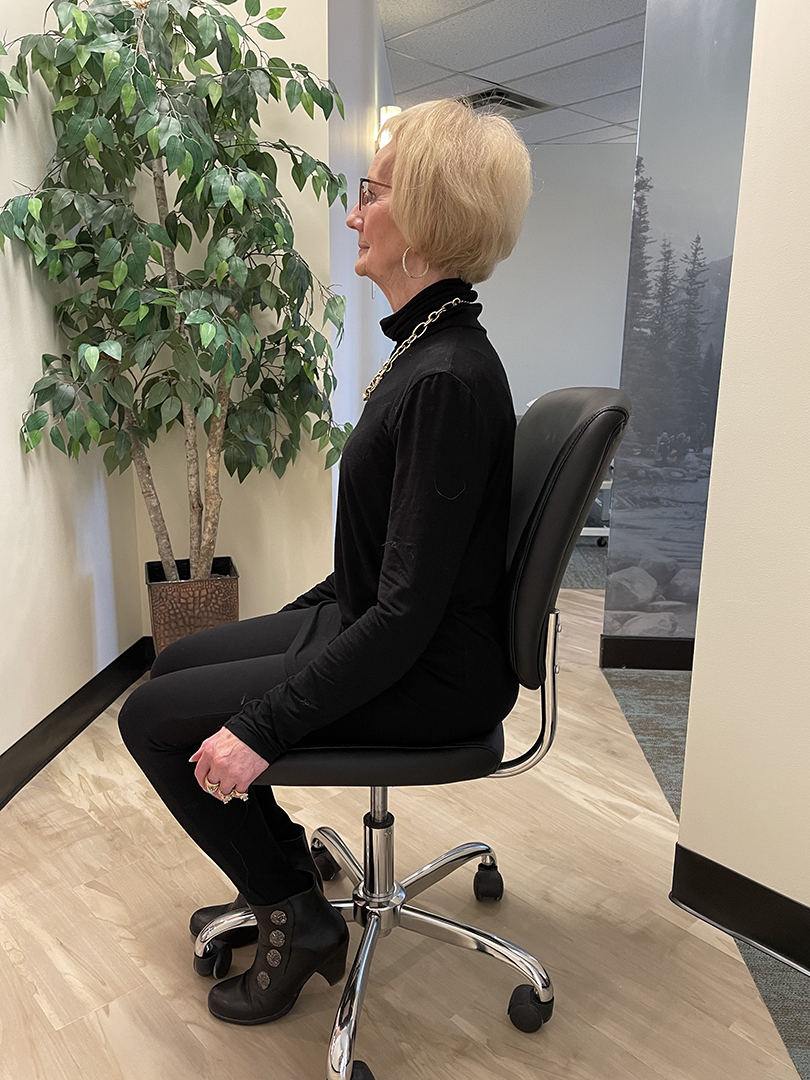
Don’t forget to keep those feet on the floor! It can be tempting to cross your legs, pivot, or perch, but these positions will make it more difficult for you to maintain a good sitting posture.
Tips To Improve Your Posture While Sitting On A Couch Or Bed
Maintaining and improving your sitting posture is easier when you are on a chair or firm surface, but what about sitting on a couch or bed? This is when props come in handy. When sitting on the couch, put a pillow or blanket behind your lower back and allow yourself to lean back slightly to avoid slouching.
Sitting in bed watching TV can be especially problematic because we are more likely to place our bodies at unnatural angles. Make use of the pillows on your bed to prop yourself so your back and neck are supported. Avoid positions that will cause you to look down or to the side for long periods of time. Make a point to move and stretch occasionally.
Tips To Improve Your Posture While Sitting At A Desk
If you have an office job, you may already be familiar with the aches and pains that can come with sitting for extended periods of time! It is, for this reason, that posture while sitting at a desk is so important. Not only are we sitting but we are engaging in repetitive tasks and movements that, over time, can strain our muscles and cause pain and injury.
If you work at a desk, ergonomics (making your workplace fit your needs) is your best friend. The basic principles of sitting posture still apply, but you’ll need to curate your work set-up to be ergonomically friendly.
A good chair can go a long way in helping to improve your posture while sitting, so make sure you get your bum to the back of the chair to take advantage of the lumbar support. This will keep your low back straight, and help your shoulders to stay back and chin tucked in. The chair height should be positioned so that your feet rest flat on the ground and your hips and knees bent to 90 degrees.
The keyboard and mouse pad are positioned so that your wrists are straight and your elbows are bent to 90 degrees and by your sides. You may have to use a keyboard/mouse pad tray to accomplish this to be able to get your body close enough to your keyboard and mouse, and to allow your feet to stay on the ground.
Lastly, you will also want to make sure that the middle of your computer screen is at or slightly below eye level. Many screens come with adjustable height stands, but if yours doesn’t you’ll have to get a couple of books to raise your screen.
Do you struggle to remember to maintain good posture while sitting?
If remembering to maintain good posture while sitting is problematic for you, try placing a coloured sticky note on your computer monitor that reminds you to sit up straight, pull your shoulders back and slightly tuck your chin in. And make a point to stand up and walk around or stretch at least once every half hour, so your body has a chance to move and stretch.
If you spend a good amount of your day at a desk, don’t ignore aches and pains that may be the result of poor posture!
Contact a physiotherapist today to find out how you can address the problem now and avoid pain and injury later down the road.
How To Improve My Posture While Sleeping
Maintaining a good posture while sleeping is not something many of us think to do, but the way we sleep can have a huge impact on our bodies.

The best way to improve your posture while sleeping is to make sure that the proper strategies referred to are implemented. Whether sleeping on your back or side, ensure that your back is straight, and your neck is aligned with the rest of your spine.
Lying on your back is preferable with a firm mattress and a pillow that leaves your neck straight with the rest of your body. If you have back problems, or experience pain while sleeping on your back, consider placing a pillow under your knees.
If you prefer to sleep on your side, keep your knees only slightly bent with a pillow between your knees and ankles to avoid the spine and pelvis from tilting and twisting. Use a pillow that prevents your head from tilting more toward one shoulder than the other – keep your head in the middle between both shoulders. Also, avoid having your head poking forward, tuck your chin in slightly to keep your neck in line with the rest of your spine. Stay away from positions that encourage you to crunch up or lie at awkward angles.
How To Improve My Posture While Walking
Walking is a great opportunity to practice and maintain good posture. Good walking posture will help your body move more naturally while reducing the stress on your muscles and joints.
Your posture while walking should be similar to your standing posture: back straight, shoulders relaxed and back, arms hanging naturally, and chin tucked in and parallel to the ground. Pay attention to your core and make sure to keep your abs tucked in and engaged. Keep your gaze straight and try to avoid the tendency to look down, which encourages slouching.
Visualize yourself walking strongly and confidently. This will help you improve your posture while walking and, as an added bonus, help you look (and feel) more confident.
How To Improve My Posture While Driving
Some of us (especially those with long commutes) spend a lot of time in our cars. Luckily, most cars have controls that allow you to adjust your seat for better posture, so improving your posture while driving just got easier!
To improve your posture while driving:
- Make sure your tailbone is flush against the back of your seat, taking advantage of the seat’s lumbar support.
- Your thighs should be supported with knees slightly lower than your hips.
- The backrest should be fairly upright and your chair close enough to the steering wheel to avoid you having to reach for it.
- Sit up straight and ensure your mirrors are properly adjusted so you don’t have to crank your neck to look at them.
- Relax your arms and shoulders! With your hands at the 9 & 3 O’clock position. Without knowing it, many people hold tension in their arms and shoulders when driving.
If you cannot seem to properly adjust your seat or don’t have automatic seat controls, consider using lumbar support accessories. A good habit is also to shift and stretch when you are at a red light. This will help release any tension you may have from sitting in the car for too long.
6 Exercises To Help Fix Your Posture
Try these six exercises to help fix your posture:
1. Corner of the Wall Pec Stretch
Position yourself facing the corner of the wall, raise your arms out to the side with your elbows at approximately shoulder height. Bend elbows and place them against each wall. Take a small step forward.
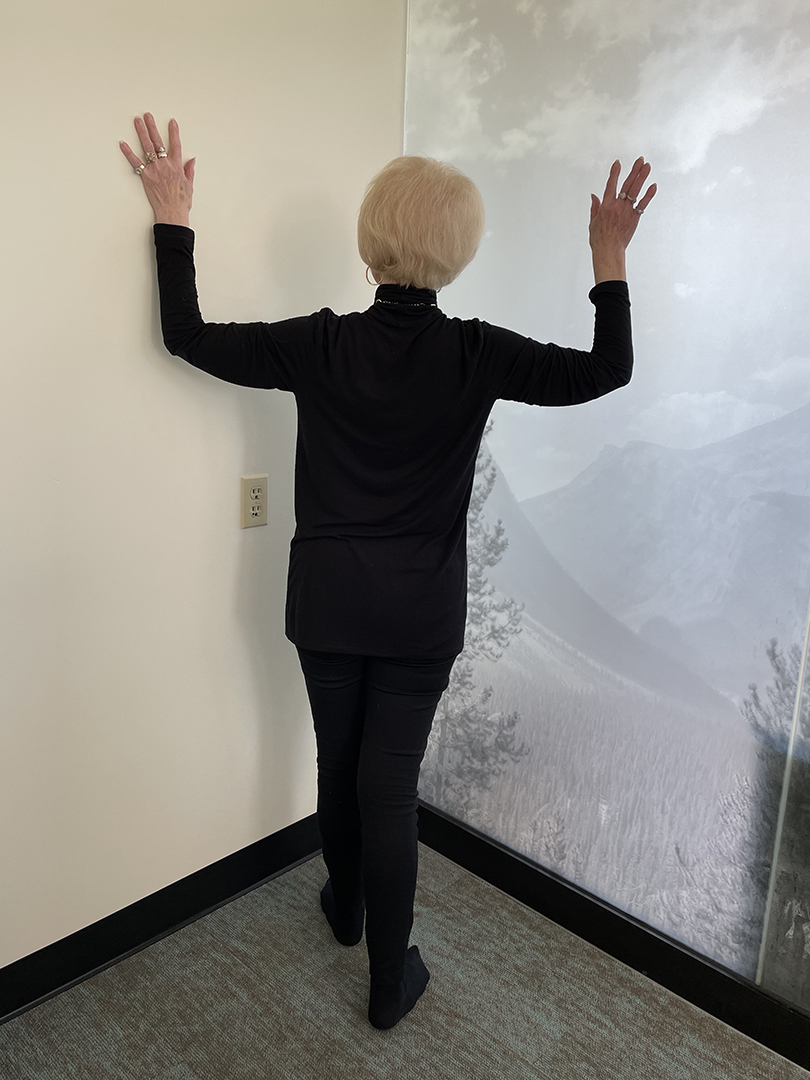
This will push your arms gently backward and you should feel a stretch in your chest area. Hold for 30 seconds and repeat 3 times, 1-2 times per day.
2. Kneeling Hip Flexor Stretch
Kneel on one knee with your other knee bent and foot flat on the floor. Keep your back upright, squeeze your gluts together and move or lunge your body forward until you feel a gentle stretch in front of your thigh on the leg that you’re kneeling on.
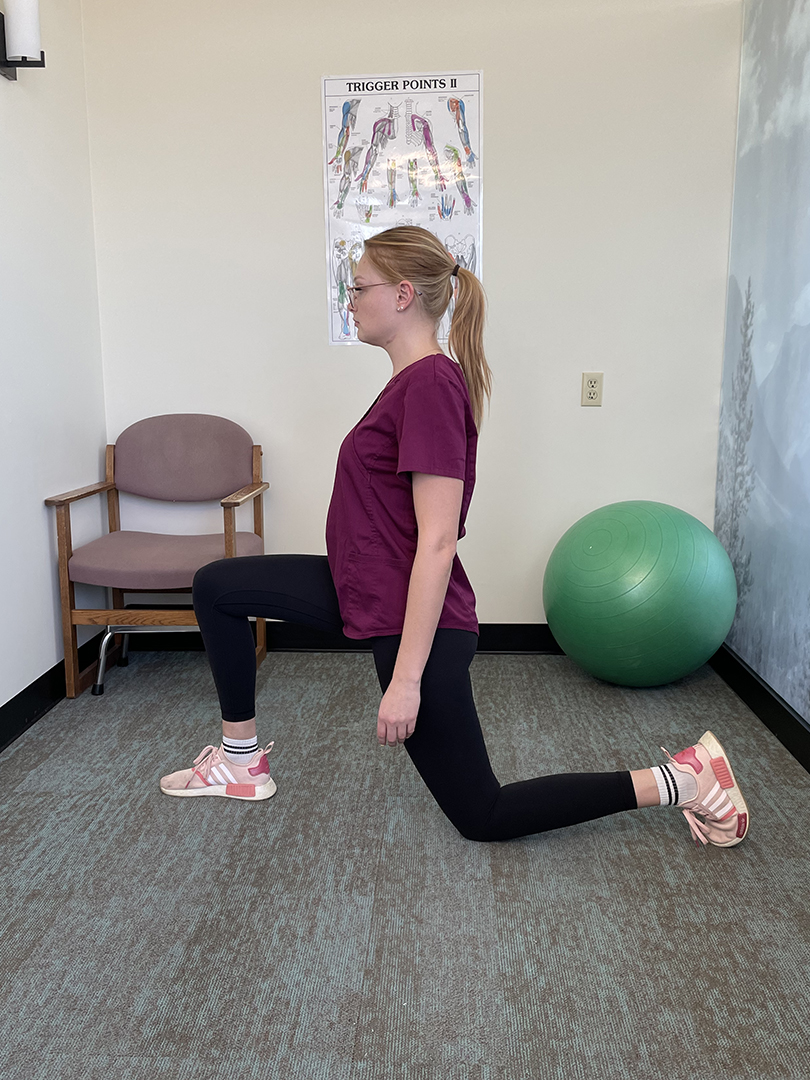
Hold for 30 seconds and repeat 3 times, 1-2 times per day.
3. Bent Over Rows
Place your feet pointing forward and slightly wider than shoulder width apart. Start with 5-10 pound dumbbells in each hand. Arch your lower back or ‘stick your bum out’ until you feel tension in your lower back (if you can’t do this very well, practice before doing the exercise). Tighten your stomach muscles. Then push your bum straight back, this will force you to bend forward at the crease of your hips. Keep your legs as straight as you can without hyperextending the knees and let your arms hang down.
Maintain the arch in your lower back and keep your upper back straight, your shoulders down and back and your chin tucked in. Bend further forward at your hips until your back is at least at a 45 degree angle and bend even further if you’re able (as long as you can keep your back arched and your shoulders down and back).
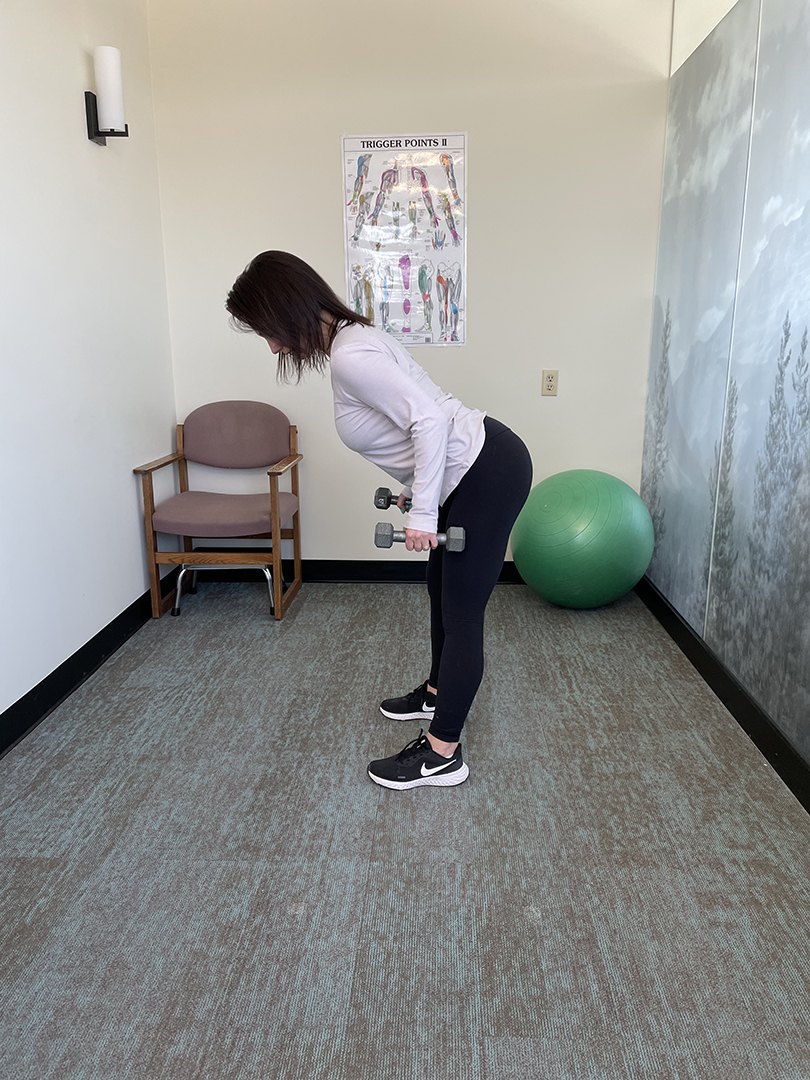
Pull your arms in by bringing your elbows to your side, pause and slowly lower them down. Do 3 sets of 10 repetitions, 1-2 times per day.
If at any time you let go of your arched back, start over again. The exercise has a high potential to cause an injury to your low back if you don’t keep it protected in the arched position.
4. Squats
You can hold a 10-15 pound dumbbell or kettlebell in front of you at chest height. Start in the same position as with the bent over row – low back arched, stomach tight and push your bum backwards. Now lower your bum to the floor and push it back as if you were going to sit down, aiming your bum to the back of the chair. As you do this, your knees will bend – they should stay behind the tips your toes and your body weight will be on your heels (your toes may lift off the ground).

Always keep your low back arched and your upper back straight with your shoulders down and back. If you lose the arch in the low back, get it back. Do 3 sets of 10 repetitions, 1-2 times per day.
Watch for how low you go in the squat; if you go too low, you will lose the arch in the low back, which means you’re squatting too deep.
5. Scapular Prone Fly
Lie on your stomach (prone position) with a pillow under your chest and a small rolled-up towel under your forehead. Have your arms by your side, palms downs and position your head straight down. Pull your shoulders blades down and together. Once your shoulders are in the correct position, lift your arms off the ground approximately 1 inch, keeping your head resting on the towel.
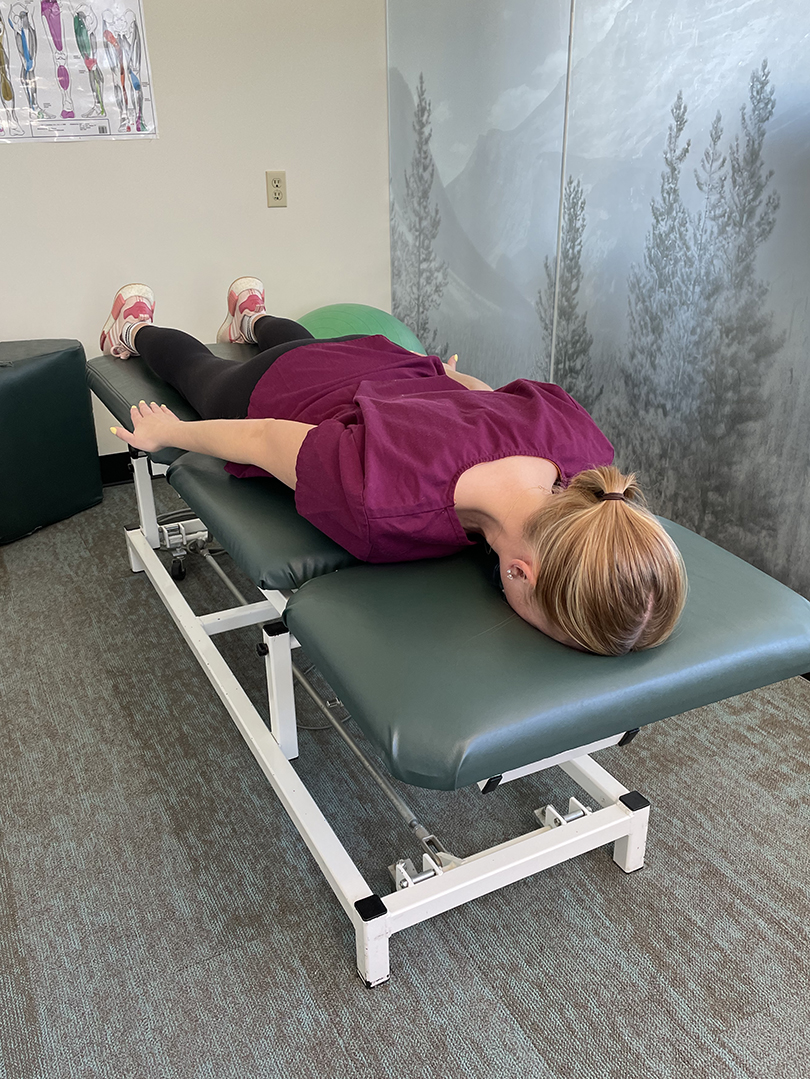
Hold 10-30 seconds, repeat 5 times. Repeat 1-2 times per day. Make sure to keep your shoulder blades down and back for the entire exercise. If you’re not able to, stop the exercise and start over.
6. Front Plank
Start on your stomach, resting on your elbows with the tips of your toes on the ground. Tighten your stomach and lift your pelvis off the floor so only your elbows and toes are supporting your weight. Your body should form a straight line from your ears and shoulders to your ankles.
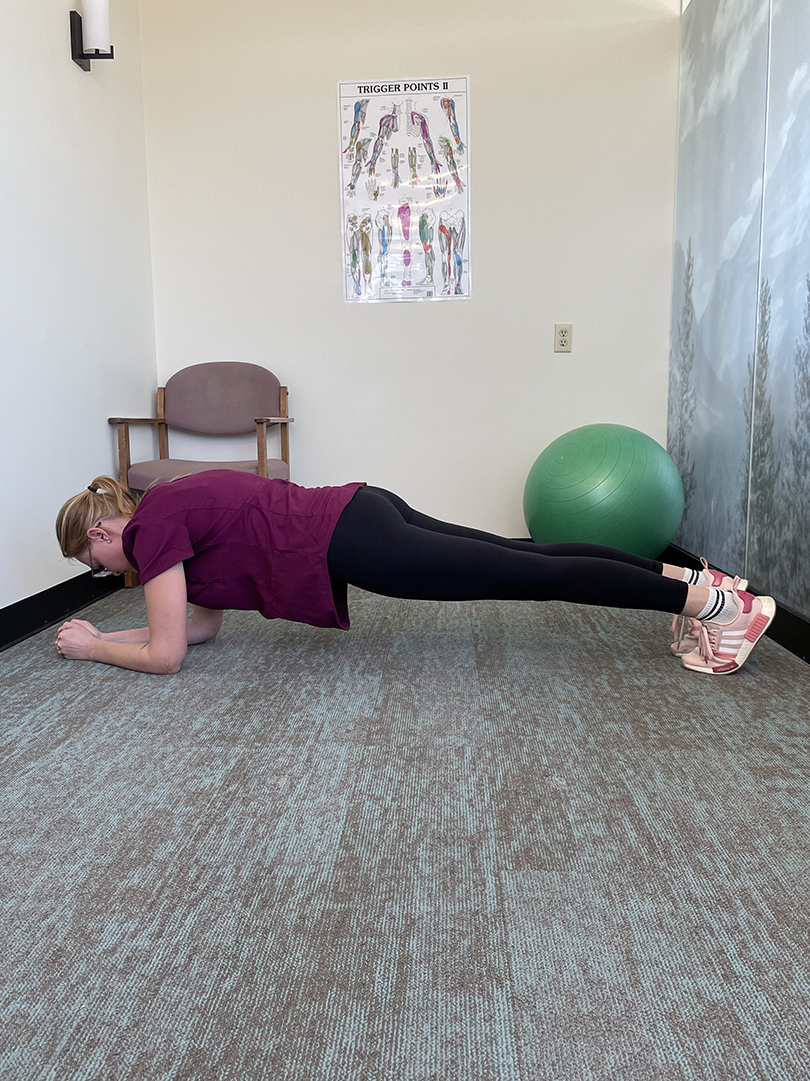
Hold 10-30 seconds, repeat 5 times. Repeat 1-2 times per day. Don’t hold your breath, keep breathing!
4 Stretches To Help Fix Your Posture
Try these four stretches to help fix your posture:
1. Neck Range of Motion
Moving only your head, drop your chin down towards your chest and hold for a count of five. Tilt your head to the right, bringing your right ear towards your shoulder. Hold for a count of five and then repeat on your left side.
Do this 3-5 times, and try to perform every couple of hours to ease stiff muscles in the back of your head and neck.
2. Shoulder Shrug
From either a sitting or standing position, raise your shoulders and shoulder blades to your ears. Hold for five seconds and then pull your shoulder blades down and towards each other.
Do this 5-10 times every couple of hours to reduce muscle tension in your shoulders.
3. Upper-Body Stretch
Find an empty corner and stand with your arms raised, hands flat against the walls on either side. Keep your elbows at shoulder height. Then place one foot ahead of the other and lean your body toward the corner, bending your forward knee. You should feel a good stretch in your chest as you hold this position for 20-30 seconds.
Repeat this 2-3 times and do it twice a day.
4. Standing Side Bend
From standing, touch your left hand to the left side of your head and then lean to the right. You should feel a stretch along the left side of your body and your shoulder.
Hold for 5-10 seconds and then switch sides.
Frequently Asked Questions About Posture
Learning how to improve your posture is a common problem, and there is a lot of information out there on the topic! To help sort fact from fiction, we’ve put together answers to some of the most commonly asked questions:
How long does it take to fix posture?
Consistent daily changes in your posture can result in feeling better quickly, but any real change will take a few months or longer. It depends on how long you’ve had poor posture. If you’re young, then it will take less time to correct your posture compared to if you’re older and the muscles have weakened and tightened.
Like any exercise program, your dedication and commitment will make a difference. Setting daily reminders, doing posture strengthening exercises, and making sure your environment is curated for good posture will all help you fix your bad posture more quickly.
Do squats help improve posture?
Squats are a good way to target many of the body’s muscles! And since squats engage the abs and core, they will help to strengthen the muscles you need to improve your posture.
However, squats are only helpful to improving your posture if they are done correctly with proper technique. See our recommended exercises above to read more about how to do a proper squat.
Does fixing your posture hurt?
Fixing your posture requires stretching tight muscles and strengthening weakened ones. When your body is doing something it is not used to doing, the result can lead to mild residual aches and pains, just as starting any new activity might result in mild stiffness. However, done properly and gradually, improving your posture should be relatively painless.
If you are experiencing pain while trying to improve your posture, we can help! Our experienced physiotherapists can assess your posture and recommend the best treatment so you can feel better fast.
Is it possible to never slouch?
It’s not realistic to eliminate slouching entirely, but we can make sure that we are maintaining good posture most of the time. Developing a healthy posture can be difficult at first, but as we build strength and flexibility and become more aware of how we position our body, good posture will become the default.
Are you dealing with aches and pains as a result of poor posture?
For a guided set of exercises and some initial pain release, book an appointment with one of our physiotherapists today! No doctor referral is needed.
